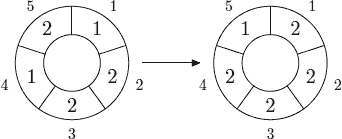http://poj.org/problem?id=3150
这题裸的矩阵很容易看出,假设d=1,n=5那么矩阵是这样的
1 1 0 0 1
1 1 1 0 0
0 1 1 1 0
0 0 1 1 1
1 0 0 1 1
这是n^3的,可是n<=500,显然tle
我们观察这个n×n的矩阵,发现没一行都是由上一行向右移得到的。
而根据Cij=Aik×Bkj,我们可以发现,其实Bkj==Akj==Ai(j-k)
那么就可以降二维变一维,每一次只要算第一行即可,即Cj=Ak*Bj-k

#include <cstdio>
#include <cstring>
#include <cmath>
#include <string>
#include <iostream>
#include <algorithm>
using namespace std;
#define rep(i, n) for(int i=0; i<(n); ++i)
#define for1(i,a,n) for(int i=(a);i<=(n);++i)
#define for2(i,a,n) for(int i=(a);i<(n);++i)
#define for3(i,a,n) for(int i=(a);i>=(n);--i)
#define for4(i,a,n) for(int i=(a);i>(n);--i)
#define CC(i,a) memset(i,a,sizeof(i))
#define read(a) a=getint()
#define print(a) printf("%d", a)
#define dbg(x) cout << #x << " = " << x << endl
#define printarr(a, n, m) rep(aaa, n) { rep(bbb, m) cout << a[aaa][bbb]; cout << endl; }
inline const long long getint() { long long r=0, k=1; char c=getchar(); for(; c<'0'||c>'9'; c=getchar()) if(c=='-') k=-1; for(; c>='0'&&c<='9'; c=getchar()) r=r*10+c-'0'; return k*r; }
inline const int max(const int &a, const int &b) { return a>b?a:b; }
inline const int min(const int &a, const int &b) { return a<b?a:b; }
typedef long long matrix[505];
void mul(matrix a, matrix b, matrix c, int lb, int lc, long long md) {
matrix t;
rep(j, lc) {
t[j]=0;
rep(k, lb)
if(j-k>=0) t[j]=(t[j]+a[k]*b[j-k])%md;
else t[j]=(t[j]+a[k]*b[lb+j-k])%md;
}
rep(j, lc) c[j]=t[j];
}
matrix a, b, c;
int main() {
long long n, m, d, k;
cin >> n >> m >> d >> k;
rep(i, n) read(c[i]);
a[0]=b[0]=1;
rep(j, d+1) a[j]=1;
for2(j, n-d, n) a[j]=1;
while(k) {
if(k&1) mul(a, b, b, n, n, m);
mul(a, a, a, n, n, m);
k>>=1;
}
mul(c, b, c, n, n, m);
rep(i, n) printf("%lld ", c[i]);
return 0;
}
Description
A cellular automaton is a collection of cells on a grid of specified shape that evolves through a number of discrete time steps according to a set of rules that describe the new state of a cell based on the states of neighboring cells. The order of the cellular automaton is the number of cells it contains. Cells of the automaton of order n are numbered from 1 to n.
The order of the cell is the number of different values it may contain. Usually, values of a cell of order m are considered to be integer numbers from 0 to m − 1.
One of the most fundamental properties of a cellular automaton is the type of grid on which it is computed. In this problem we examine the special kind of cellular automaton — circular cellular automaton of order n with cells of order m. We will denote such kind of cellular automaton as n,m-automaton.
A distance between cells i and j in n,m-automaton is defined as min(|i − j|, n − |i − j|). A d-environment of a cell is the set of cells at a distance not greater than d.
On each d-step values of all cells are simultaneously replaced by new values. The new value of cell i after d-step is computed as a sum of values of cells belonging to the d-enviroment of the cell i modulo m.
The following picture shows 1-step of the 5,3-automaton.

The problem is to calculate the state of the n,m-automaton after k d-steps.
Input
The first line of the input file contains four integer numbers n, m, d, and k (1 ≤ n ≤ 500, 1 ≤ m ≤ 1 000 000, 0 ≤ d < n⁄2 , 1 ≤ k ≤ 10 000 000). The second line contains n integer numbers from 0 to m − 1 — initial values of the automaton’s cells.
Output
Output the values of the n,m-automaton’s cells after k d-steps.
Sample Input
sample input #1 5 3 1 1 1 2 2 1 2 sample input #2 5 3 1 10 1 2 2 1 2
Sample Output
sample output #1 2 2 2 2 1 sample output #2 2 0 0 2 2
Source